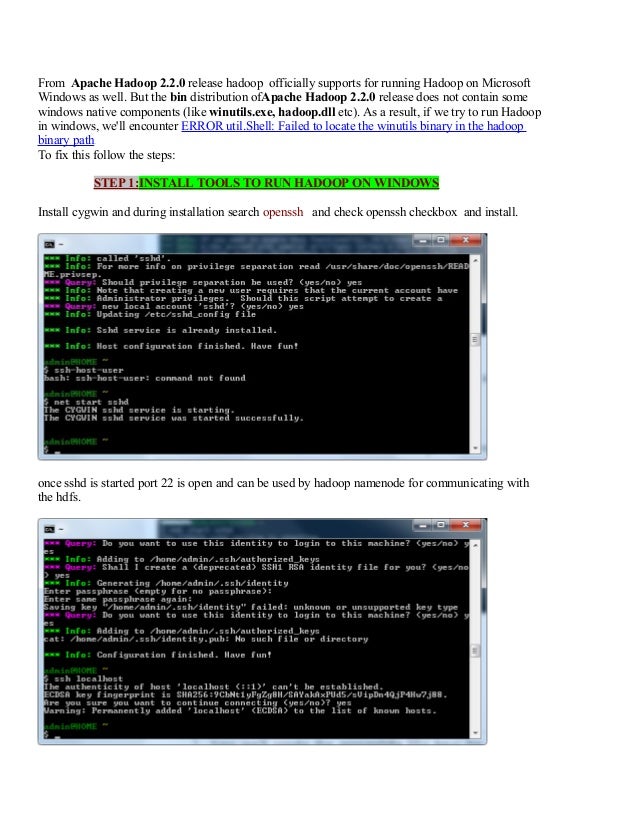Winutils Exe Hadoop Download For Mac
If you do not want to run Apache Spark on Hadoop, then standalone mode is what you are looking for. Here are the steps to install and run Apache Spark on Windows in standalone mode. Java is a prerequisite for running Apache Spark. Install Java 7 or later. If not present, download Java from.
Set JAVA_HOME and PATH variables as environment variables. Then execute the installer.
Choose the first option of 'Download Scala x.y.z. Binaries for your system'. Set the environment variables, SCALA_HOME to reflect the bin folder of downloaded scala directory. For example, if you have downloaded Scala in C: scala directory then set SCALA_HOME=C: scala PATH=C: scala bin Also, you can set _JAVA_OPTIONS environment variable to the value mentioned below to avoid any Java Heap Memory problems you encounter, if any.
_JAVA_OPTIONS= -Xmx512M -Xms512M 5. To check if Scala is working or not, run following command. >Iso 9001 Management Review Meeting Presentation Techniques. scala -version Picked up _JAVA_OPTIONS: -Xmx512M -Xms512M Scala code runner version 2.11.8 -- Copyright 2002-2016, LAMP/EPFL 6. Spark can be installed in two ways. • Building Spark using SBT • Use prebuilt Spark package Lets choose a Spark prebuilt package for Hadoop from. Download and extract it to any drive.
Set SPARK_HOME and PATH environment variable to the downloaded spark folder. For example, if you have downloaded Spark to C: Spark spark-1.6.1-bin-hadoop2.6 directory then set SPARK_HOME=C: spark spark-1.6.1-bin-hadoop2.6 PATH=C: spark spark-1.6.1-bin-hadoop2.6 bin 7. Though we aren’t using Hadoop with Spark, but somewhere it checks for HADOOP_HOME variable in configuration. So to overcome this error, download winutils.exe and place it in any location.(for example,) Download. Set HADOOP_HOME to the path of winutils.exe. For example, if you install winutils.exe in D: winutils bin winutils.exe directory then set the path to HADOOP_HOME=D: winutils Set PATH environment variable to include%HADOOP_HOME% bin as follows PATH= D: winutils bin 9. Grant permissions to the folder C: tmp hive if you get any permissions error.

You might need to copy hadoop.dll and winutils.exe files from hadoop-common-bin to%HADOOP_HOME% bin Add. Then download pre-builted winutils of Hadoop.
Tmp hive directory on HDFS should be writable. Use the below command to grant the privileges. D: spark>D: winutils winutils.exe chmod 777 D: tmp hive 10.
For testing if Spark is working or not, you can run the example from the bin folder of Spark >bin run-example SparkPi 10 It should execute the program and will return Pi is roughly 3.14.
Instructions tested with Windows 10 64-bit. It is highly recommend that you use Mac OS X or Linux for this course, these instructions are only for people who cannot run Mac OS X or Linux on their computer. Table of Contents • • • • Install and Setup Spark provides APIs in Scala, Java, Python (PySpark) and R. We use PySpark and Jupyter, previously known as IPython Notebook, as the development environment. There are many articles online that talk about Jupyter and what a great tool it is, so we won’t introduce it in details here. This Guide Assumes you already have Anaconda and Gnu On Windows installed. Go to and install Java 7+.
Get Spark pre-built package from the of the Spark project website. Open PowerShell by pressing ⊞ Win- R, typing “powershell” in Run dialog box and clicking “OK”. Change your working directory to where you downloaded the Spark package. Type the commands in red to uncompress the Spark download. Alternatively, you can use any other software of your preference to uncompress. %matplotlib inline from operator import itemgetter from matplotlib import pyplot as plt plt.figure(figsize = (10, 5)) # Plot 1 plt.subplot(1, 2, 1) plt.xlim((-1.0, 1.0)) plt.ylim((-1.0, 1.0)) sample = dots.sample(False, 0.01) X = sample.map(itemgetter(0)).collect() Y = sample.map(itemgetter(1)).collect() plt.scatter(X, Y) # Plot 2 plt.subplot(1, 2, 2) plt.xlim((-1.0, 1.0)) plt.ylim((-1.0, 1.0)) inCircle = lambda v: np.linalg.norm(v).